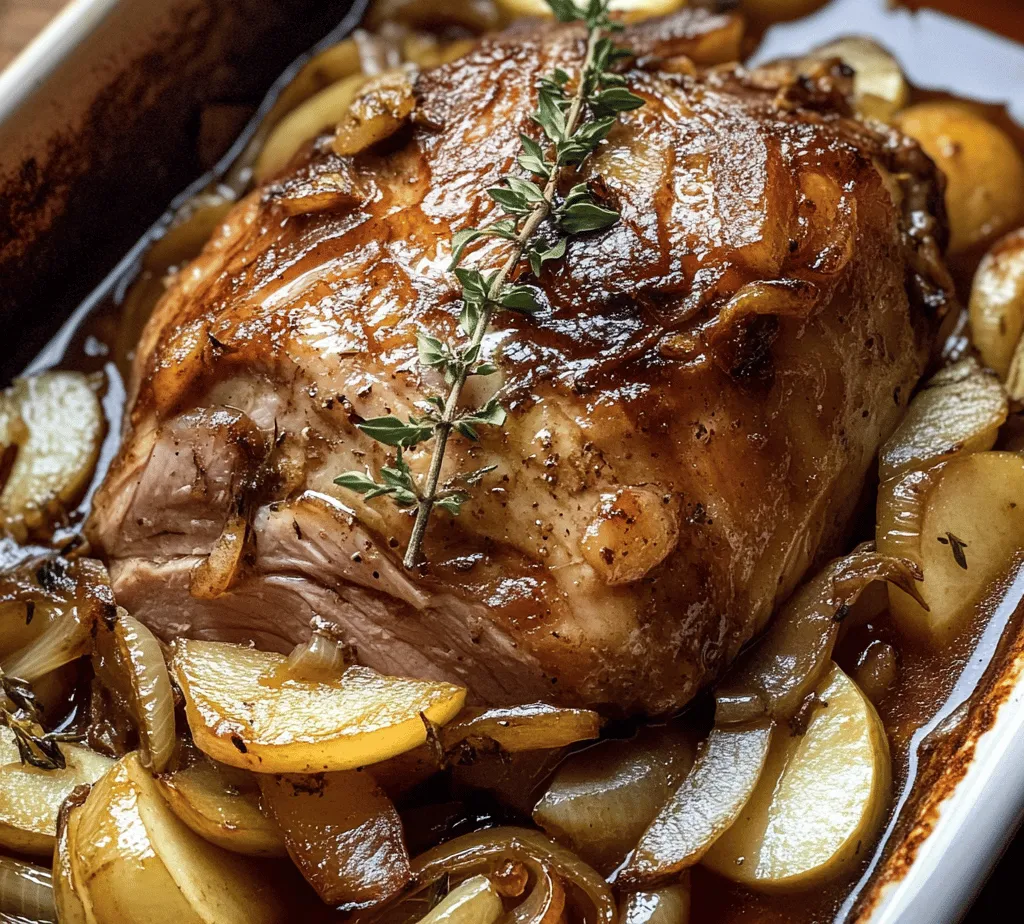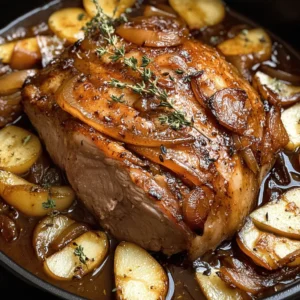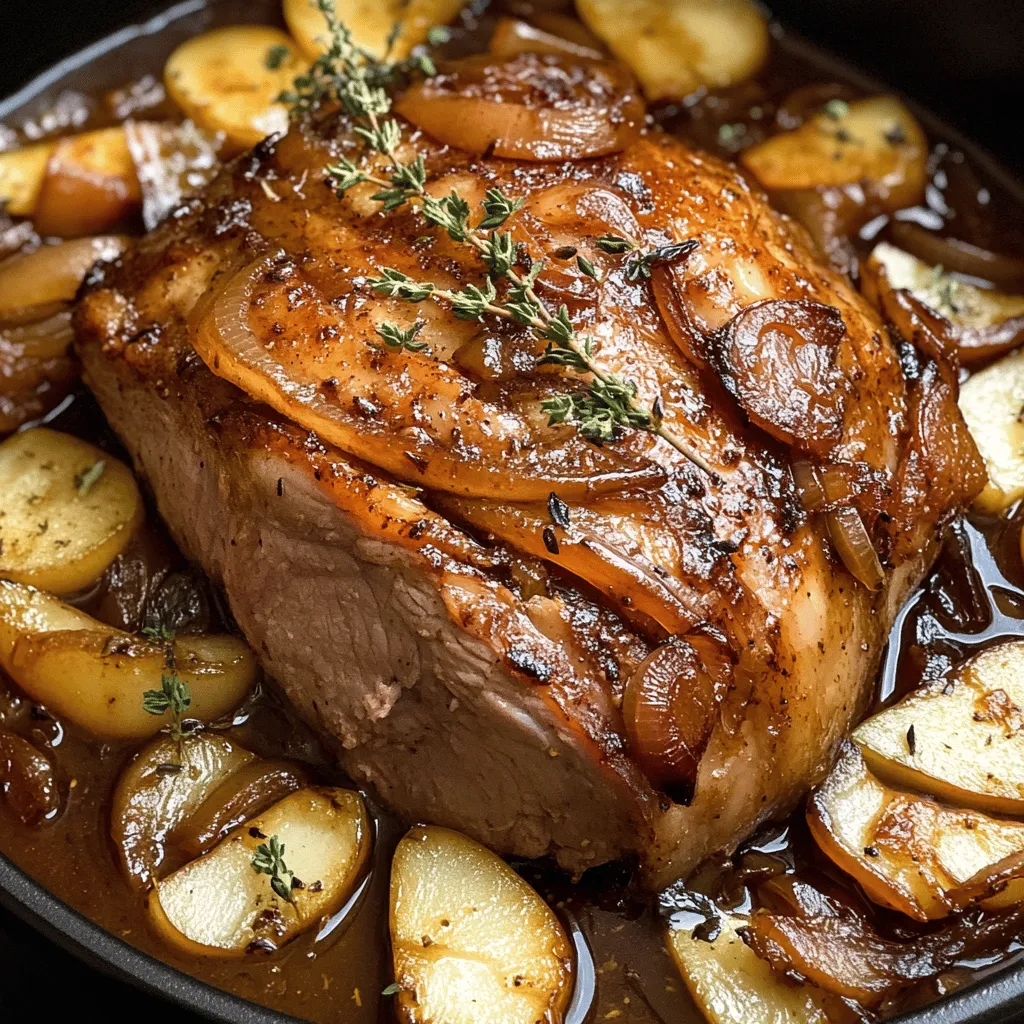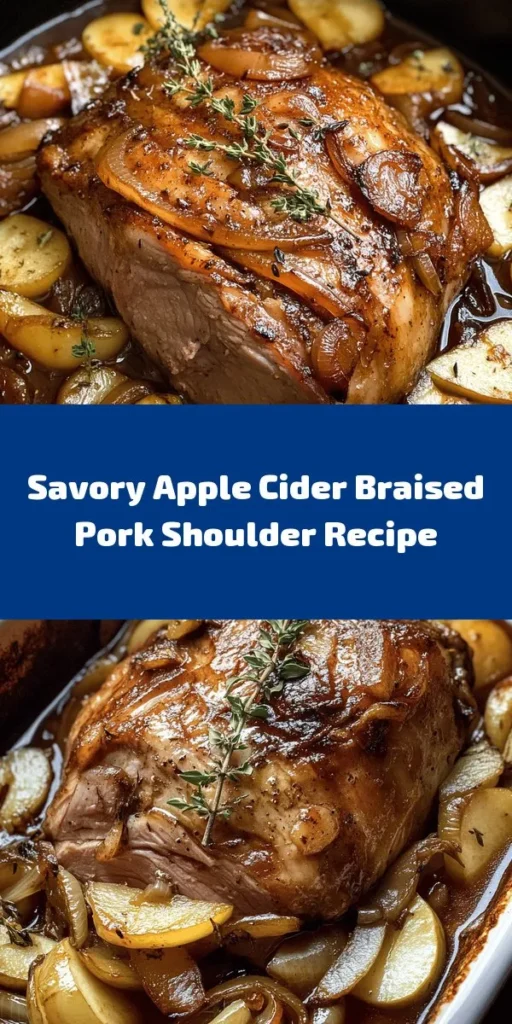Introduction
As the leaves begin to change and the air turns crisp, there’s nothing quite like the comforting aroma of a hearty, home-cooked meal wafting through the kitchen. One dish that embodies the warmth of autumn is Apple Cider Braised Pork Shoulder. This succulent recipe marries the rich flavors of tender pork with the sweet and tangy notes of apple cider, creating a dish that feels both rustic and refined. The slow cooking process allows for deep flavor development, transforming the pork shoulder into a melt-in-your-mouth masterpiece that you and your loved ones will crave time and time again.
The appeal of Apple Cider Braised Pork Shoulder lies not only in its delightful taste but also in its simplicity. With just a handful of ingredients, this dish can elevate any dinner gathering or cozy family meal. The use of apple cider not only enhances the dish with its natural sweetness but also tenderizes the meat, making it a perfect choice for those who appreciate the delicate balance of flavors. This recipe is a celebration of fall’s bounty, drawing on the season’s finest offerings to create a warm and inviting dish that is sure to impress.
Understanding the Ingredients
To achieve the best results in your Apple Cider Braised Pork Shoulder, it’s essential to understand the key ingredients and their roles in this flavorful dish.
Pork Shoulder
The star of this recipe is undoubtedly the pork shoulder, a cut known for its rich flavor and tenderness when cooked low and slow. This cut, also known as pork butt or Boston butt, is perfect for braising due to its higher fat content and connective tissue. When cooked properly, the fat renders down, infusing the meat with moisture and flavor while the collagen breaks down to create that melt-in-your-mouth texture that is so desirable in braised dishes. Choosing a well-marbled pork shoulder will ensure that your final dish is juicy, tender, and packed with flavor.
Apple Cider
Apple cider is the secret ingredient that elevates this dish from ordinary to extraordinary. Not only does it add a natural sweetness that complements the pork, but its acidity also helps to tenderize the meat. As it cooks, the cider reduces down, intensifying its flavors and creating a luscious sauce that coats the pork. When selecting apple cider, opt for a high-quality, unfiltered variety to capture the authentic taste of fresh apples. The use of apple cider not only mirrors the essence of fall but also creates a delightful harmony between sweetness and savory notes.
Aromatics
Aromatic ingredients such as onion and garlic play a crucial role in building the flavor profile of the dish. The onion adds a sweet, caramelized note once sautéed, while garlic provides a pungent depth that enhances the overall taste. Together, these aromatics create a flavorful base that complements the richness of the pork and the sweetness of the cider. Sautéing these ingredients properly is key; it allows their natural sugars to caramelize, developing a rich flavor that will permeate the entire dish.
Herbs and Spices
The addition of herbs and spices is what brings this dish to life. Fresh thyme is a classic pairing with pork, offering an earthy, herbal note that brightens the dish. A hint of cinnamon adds warmth and a subtle sweetness that pairs beautifully with the apple cider. Additionally, a touch of Dijon mustard provides a mild tanginess that balances the dish, tying all the flavors together. The careful selection and balance of these herbs and spices can elevate your braise, making it uniquely yours.
Importance of Ingredient Quality
While the recipe may seem simple, the quality of your ingredients can make a significant difference in the final outcome. Sourcing fresh, high-quality pork shoulder, unfiltered apple cider, and organic herbs will not only enhance the flavor but also contribute to the overall healthfulness of your meal. When you invest in quality ingredients, the dish itself becomes a reflection of your care and attention, resulting in a truly memorable dining experience.
Preparation Steps
Now that we understand the importance of each ingredient, it’s time to delve into the preparation steps that will set the stage for a perfect Apple Cider Braised Pork Shoulder.
Prepping the Pork Shoulder
The first step in creating this delectable dish is prepping the pork shoulder. Begin by trimming any excess fat from the meat. While a certain amount of fat is essential for flavor and moisture, too much can leave the dish greasy. Aim for a balance, leaving a thin layer of fat to maintain juiciness without overwhelming the dish.
Once trimmed, it’s vital to season the pork shoulder generously. A simple combination of salt and freshly cracked black pepper will do wonders to enhance the natural flavors of the meat. For added depth, consider rubbing in some of the Dijon mustard for a tangy kick before searing. This not only adds flavor but also helps to form a beautiful crust when seared.
Techniques for Achieving the Perfect Sear
Searing the pork shoulder is one of the most critical steps in this recipe. It creates a flavorful crust that adds complexity to the dish. To achieve the perfect sear, begin by preheating a heavy-bottomed Dutch oven or skillet over medium-high heat. Once the pot is hot, add a high smoke-point oil, such as vegetable or canola oil.
Carefully place the seasoned pork shoulder into the hot oil, allowing it to sear without moving it for several minutes. This will create a beautiful caramelized crust. Once the first side is golden brown, use tongs to flip the pork shoulder and repeat the process on all sides until a deep, golden-brown crust forms. This step is essential as it locks in flavor and moisture, ensuring that your braise is rich and satisfying.
Sautéing Aromatics
With the pork shoulder seared to perfection, it’s time to sauté the aromatics. In the same pot, add a bit more oil if necessary, and then toss in the chopped onion. Sauté the onion over medium heat until it becomes translucent and begins to caramelize, about 5-7 minutes. This process releases the natural sugars in the onion, adding sweetness to your braise.
Next, add the minced garlic and sauté for an additional minute, being careful not to let it burn. The fragrant aroma of garlic will fill your kitchen, signaling that you’re on the right track. Once the aromatics are sautéed, scrape up any browned bits from the bottom of the pot, as these will contribute to the flavor of the braising liquid.
Crafting the Braising Liquid
Now that your aromatics are ready, it’s time to craft the braising liquid. Begin by deglazing the pot with the apple cider, pouring it in to lift the flavorful bits stuck to the bottom. Stir the mixture, allowing it to simmer for a minute to reduce slightly. This step is crucial for maximizing flavor.
Next, add additional ingredients to the braising liquid, including fresh thyme, a pinch of cinnamon, and a splash of chicken broth to enhance the savory notes. The combination of sweet, savory, and slightly spicy elements will create a harmonious sauce that perfectly balances the richness of the pork. Taste the liquid and adjust the seasoning as necessary, adding salt, pepper, or even more Dijon mustard to suit your preferences.
By understanding your ingredients and following these preparation steps, you are well on your way to creating a delicious and comforting Apple Cider Braised Pork Shoulder that will impress anyone who gathers around your table.

Braising Process
The Art of Braising
Braising is a cooking technique that combines both dry and wet heat to create tender, flavorful dishes. This method is particularly well-suited for tougher cuts of meat, like pork shoulder, which benefit from a long cooking time. The process begins with searing the meat to develop a rich, brown crust. This step not only adds depth of flavor but also helps retain moisture during the cooking process. Once seared, the meat is cooked slowly in a flavorful liquid—such as apple cider in this recipe—which infuses the meat with sweetness and acidity, enhancing its natural flavors.
The beauty of braising lies in its simplicity and the way it transforms simple ingredients into a hearty, comforting meal. The combination of gentle heat and moisture breaks down collagen in the meat, resulting in a tender, melt-in-your-mouth texture that is truly exceptional. As the pork shoulder braises, it absorbs the aromatic flavors of herbs and spices, creating a dish that is both satisfying and memorable.
Timing and Temperature
To achieve perfectly braised pork shoulder, timing and temperature are crucial. Typically, the ideal braising time for a pork shoulder is between 3 to 4 hours at a low temperature—around 300°F (150°C). This slow and steady cooking allows the connective tissues to break down, making the meat tender and flavorful.
To determine doneness, look for the pork to be fork-tender. This means that a fork should easily slide into the meat with little resistance, and when pulled apart, it should shred easily. The internal temperature of the pork should reach at least 190°F (88°C) for optimal tenderness. It’s worth investing in a good meat thermometer to help monitor the cooking process and ensure that your pork is cooked to perfection.
Serving Suggestions
How to Properly Slice or Shred the Pork Shoulder
Once your Apple Cider Braised Pork Shoulder has completed its cooking time, it’s time to serve. For presentation and ease, you can either slice or shred the meat. If you choose to slice, let the pork rest for about 10-15 minutes after removing it from the braising liquid. This resting period allows the juices to redistribute within the meat, ensuring moist slices. Use a sharp knife to cut against the grain into thick slices.
If shredding, simply use two forks to pull apart the meat. The result should be tender, juicy strands that can easily be piled on a plate or used in sandwiches. Regardless of your choice, make sure to drizzle some of the braising liquid over the meat to keep it flavorful and moist.
Ideas for Serving the Dish
Apple Cider Braised Pork Shoulder can be served in a variety of ways. One classic method is to serve it on a platter alongside its braising liquid, allowing guests to help themselves. Another option is to create delicious pulled pork sandwiches by placing the shredded meat on a fresh bun, topped with coleslaw and a drizzle of the braising sauce.
For a more refined presentation, consider plating the sliced pork shoulder with a spoonful of the braising sauce, garnished with fresh herbs such as parsley or thyme. This not only adds a pop of color but also enhances the visual appeal of the dish.
Pairing with Sides
To complement the rich flavors of the braised pork, consider serving it with sides that balance the dish. Mashed potatoes are a classic choice, providing a creamy texture that pairs beautifully with the savory meat. Roasted vegetables, such as carrots, Brussels sprouts, or sweet potatoes, add a touch of sweetness and a colorful presentation to your meal.
Another excellent side is a simple green salad dressed with a light vinaigrette. The acidity of the dressing can help cut through the richness of the pork, creating a well-rounded meal. Consider serving a warm crusty bread on the side as well, perfect for soaking up any leftover sauce.
Flavor Variations and Customizations
Exploring Different Apple Varieties
One of the wonderful aspects of making Apple Cider Braised Pork Shoulder is the versatility in flavor that different apple varieties can bring. Using sweeter apple varieties, such as Honeycrisp or Fuji, will yield a sweeter braising liquid, while tart varieties like Granny Smith can add a refreshing acidity to the dish. Feel free to experiment with a mix of apple types to find a balance that suits your palate.
Adjusting Sweetness and Acidity
You can customize the sweetness and acidity of the braising liquid to align with your personal preferences. If you prefer a sweeter sauce, consider adding a touch of brown sugar or maple syrup to the cider before braising. Conversely, if you enjoy a more tangy flavor, adding a splash of vinegar—such as apple cider vinegar or balsamic vinegar—will enhance the acidity and add complexity to the dish.
Possible Additions
To elevate your Apple Cider Braised Pork Shoulder, consider adding root vegetables like parsnips, turnips, or even potatoes to the braise. These not only add flavor but also make for a more complete meal. You can also include dried fruits, such as apricots or cranberries, which will impart a delightful sweetness that pairs well with the savory pork.
Nutritional Information
Apple Cider Braised Pork Shoulder is not only delicious but can also be a nutritious addition to your meal rotation. A typical serving of this dish is rich in protein, making it a fulfilling option for your family dinner. The pork shoulder itself provides essential nutrients, including iron and B vitamins, which are vital for energy production and overall health.
As with any dish, portion control is key. A serving size of about 4-6 ounces of pork, paired with a side of vegetables or starch, can create a balanced meal. By incorporating plenty of vegetables and whole grains as sides, you can enhance the overall nutritional profile of your plate.
Conclusion
Apple Cider Braised Pork Shoulder is more than just a meal; it’s a celebration of flavors and comfort that brings warmth and joy to any gathering. The combination of tender pork infused with the sweet and tangy notes of apple cider creates a dish that is sure to impress family and friends alike.
Cooking this dish allows you to embrace the art of slow cooking, filling your home with enticing aromas and the promise of a hearty meal. Whether served at a formal gathering or a cozy family dinner, this recipe holds a special place in the hearts of many.
So, gather your ingredients, embrace the process of braising, and enjoy the delightful flavors of Apple Cider Braised Pork Shoulder. This dish is not just about satisfying hunger; it’s about creating memories and enjoying the comforting embrace of home-cooked food.



